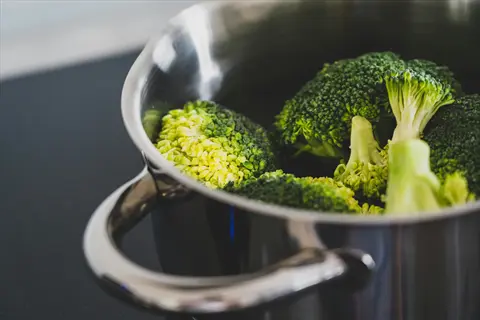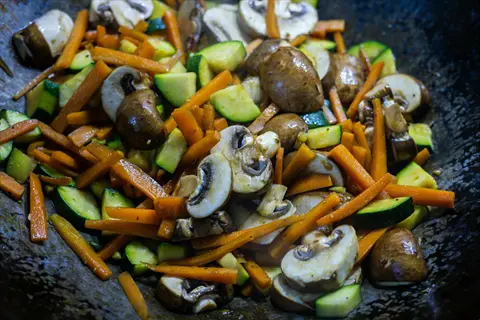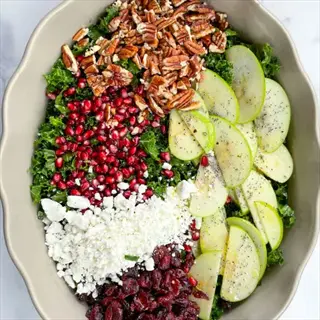Essential Healthy Food Benefits Everyone Should Know

Written by
David Nelson
Reviewed by
Prof. Graham Pierce, Ph.D.The benefits of a healthy diet are continued energy and improved cognitive function through the collective effect of many nutrients.
Omega-3 fatty acids and soluble fiber are potent in improving cardiovascular health indicators.
Plant compounds in colorful produce trigger cellular repair, which contributes to longevity.
Protein-fiber combinations maximize satiety to aid long-term successful weight management.
Fermented foods that promote a healthy gut can also stabilize moods be balancing the microbiome.
Drinking enough water and mindfully eating support stopping overeating on accident.
Article Navigation
Imagine a plate overflowing with colorful berries, crisp greens, and golden sweet potatoes. They offer a range of benefits from healthy food that can enhance your daily life. You will feel the natural rise of energy. Your spirits will be as bright as sunlight streaming through the window.
Eating healthily means making simple choices, not adhering to a rigid eating plan. Give up that sweet snack for a handful of almonds and an apple, and feel clarity come. Rest becomes deeper. You feel better every day, and you have greater vitality and peace.
Smart Snacking Ideas
For smart snacking, it's best to combine protein and fiber for sustained energy. Snack on celery sticks filled with almond butter or serve chickpea hummus with cucumber slices. These combinations prevent the sugar crash that comes with candy bars. You can stay mentally alert for hours without hunger.
For quickly and healthily filling in nutrition, plant foods work best. Five minutes is sufficient to make chocolate avocado pudding with crushed silken tofu. Or try sprinkling edamame beans with sea salt. Instead of chips, which have empty calories, you get nutrition and vitamins.
For frenetic days, portability is important. Prepare overnight oats in jars with chia seeds and berries. Or pack cut-up vegetables with single-serving containers of hummus. These whole foods provide sustained energy without additives, outperforming processed foods.
Carrot Sticks with Hummus
- Crunchy carrots paired with protein-rich hummus create satisfying texture contrast. This combination delivers fiber and plant-based protein for steady energy without blood sugar spikes.
Apple Slices with Almond Butter
- Crisp apple slices spread with almond butter offer healthy fats and natural sweetness. This snack provides sustained energy and helps manage hunger between meals effectively.
Greek Yogurt with Berries
- Creamy Greek yogurt topped with antioxidant-rich berries creates balanced nutrition. This combination offers probiotics for gut health and vitamins for immune support.
Hard-Boiled Eggs
- Portable hard-boiled eggs deliver high-quality protein and essential nutrients. They provide choline for brain function and selenium for antioxidant protection conveniently.
Mixed Nuts and Seeds
- Combination of almonds, walnuts and pumpkin seeds offers healthy fats. This snack provides magnesium for muscle function and zinc for immune support.
Cottage Cheese with Pineapple
- Creamy cottage cheese paired with pineapple chunks offers calcium and vitamin C. This combination supports bone health and aids nutrient absorption efficiently.
Whole-Grain Crackers with Avocado
- Fiber-rich crackers topped with mashed avocado provide monounsaturated fats. This snack supports heart health and helps maintain healthy cholesterol levels.
Edamame with Sea Salt
- Steamed edamame pods sprinkled with sea salt offer complete plant protein. They provide iron for oxygen transport and folate for cell renewal.
Turkey and Cheese Roll-Ups
- Lean turkey slices wrapped around cheese provide high-quality protein. This combination offers calcium for bones and B vitamins for energy metabolism.
Banana Oatmeal Cookies
- Homemade cookies made from bananas and oats deliver fiber naturally. They provide potassium for muscle function without added processed sugars.
Healthy Cooking Techniques
Opt for steaming instead of boiling since important vitamins such as vitamin C and folate are lost in cooking water. Steam broccoli and carrots until they are bright green, so that they retain their goodness. This gentle method is superior to boiling, when nutrients are frequently lost down the sink (as much as 50%).
Sauté your onions or mushrooms in vegetable broth or lemon juice in place of oil. They will add flavor without added fat. How about stir-frying them with a splash of wine or apple cider vinegar for a different taste with caramelization? Your heart will appreciate the immediate decrease in cholesterol intake.
Minimize heat to avoid deadly carcinogens. Try grilling at temperatures below 400 degrees and frequently flip the meat portions to ensure even cooking. Bake potatoes whole rather than frying, so you can avoid producing the deadly acrylamide. Correct temperatures protect your cells and your body's ability to retain maximum minerals with every mouthful you take.
Correlate techniques with results: poaching of fish retains the fragile omega-3s for brain benefits; roasting tomatoes enhances the lycopene absorption for skin benefits. Each technique has its own benefits. Your body gets a greater benefit from good cooking than it does from a diet of raw foods alone.

Steaming
- Gentle steam heat preserves water-soluble vitamins like vitamin C and B-complex that boiling destroys. This method retains up to 50% more nutrients compared to boiling vegetables in water.
- Steaming requires no added fats, making it ideal for low-calorie diets while maintaining vegetable crispness and natural flavors. The moist heat helps vegetables maintain their structural integrity during cooking.
- This technique enhances the bioavailability of antioxidants like beta-carotene in carrots and sweet potatoes. The enclosed environment prevents nutrient loss through evaporation or leaching into cooking water.
- Steaming baskets allow simultaneous preparation of proteins like fish and vegetables for balanced meals. The vertical stacking enables efficient use of stove space and energy conservation.
- Delicate greens like spinach and kale retain vibrant color and texture when steamed briefly. Short cooking times between three to five minutes prevent overcooking and nutrient degradation.
- Research indicates steaming increases sulforaphane content in broccoli, a compound with anticancer properties. The method activates myrosinase enzymes that convert glucosinolates into beneficial phytochemicals.

Baking
- Even dry heat circulation in ovens caramelizes natural sugars without added fats, enhancing flavor. This creates complex taste profiles in vegetables like Brussels sprouts and sweet potatoes.
- Baking parchment or silicone mats eliminate oil needs while preventing food from sticking. The non-stick surfaces allow easy cleanup and promote low-fat cooking approaches.
- Controlled temperatures between 350-400°F (177-204°C) prevent formation of harmful acrylamides in starchy foods. Moderate heat preserves nutrients while achieving desirable browning and texture.
- En papillote technique seals fish and vegetables in parchment, steaming in their juices. This French method concentrates flavors while preserving moisture-sensitive vitamins like riboflavin.
- Baking whole potatoes with skin retains potassium and fiber often lost during peeling. The skin acts as a protective barrier against nutrient loss during cooking.
- Research shows baking maintains higher folate levels in foods compared to frying methods. The stable indirect heat prevents degradation of heat-sensitive B vitamins effectively.

Stir-Frying
- Rapid high-heat cooking in woks seals surfaces quickly, locking nutrients inside ingredients. The technique preserves crunch in vegetables while minimizing oil absorption during cooking.
- Using broth or wine instead of oil reduces fat content by up to 80%. These liquids create steam that cooks ingredients while adding complex flavors without calories.
- Constant movement prevents burning and carcinogen formation associated with prolonged high heat. The tossing action ensures even exposure to heat for uniform cooking results.
- Thin slicing increases surface area for faster cooking and better nutrient retention. Smaller pieces require shorter cooking times, preserving heat-sensitive vitamins like vitamin C.
- Adding aromatics like garlic and ginger at the end preserves their medicinal compounds. Delayed introduction maintains allicin in garlic, known for cardiovascular benefits.
- Research indicates stir-frying increases lycopene bioavailability in tomatoes compared to raw consumption. The quick heat breaks cell walls, releasing antioxidants while preserving nutrients.

Grilling
- Marinating proteins before grilling reduces heterocyclic amine formation by up to 90%. Acidic components like vinegar or lemon juice create protective barriers on food surfaces.
- Using vegetable baskets prevents small pieces from falling through grates while minimizing charring. The containers allow even cooking without direct flame contact that causes burning.
- Precooking vegetables slightly preserves moisture and reduces time over high heat exposure. Blanching beforehand maintains texture while decreasing carcinogen risks during grilling.
- Herb rubs instead of sugary sauces prevent charring and add antioxidant benefits. Rosemary and thyme contain compounds that counteract potential carcinogens from smoke.
- Indirect heat methods with two-zone fires prevent fat flare-ups that create smoke. This technique reduces polycyclic aromatic hydrocarbon deposition on food surfaces significantly.
- Research shows grilled vegetables retain more potassium and magnesium than boiled versions. The dry heat concentrates minerals while maintaining structural integrity of produce.

Poaching
- Submerging food in simmering liquid cooks proteins gently without adding fats or oils. The low-temperature method between 160-180°F (71-82°C) prevents toughness in delicate foods.
- Using broth or tomato juice instead of water infuses flavor without sodium concerns. These liquids add depth while contributing additional nutrients to the finished dish.
- Acidic poaching liquids like wine or vinegar help firm proteins while enhancing tenderness. The pH environment promotes even coagulation of egg whites or fish proteins.
- Covered poaching traps steam, maintaining moisture without constant temperature monitoring. The enclosed environment creates consistent results with minimal attention required.
- Fruit poaching in spice-infused liquids enhances natural sweetness without added sugars. Cinnamon and star anise contribute antioxidants while reducing need for sweeteners.
- Studies indicate poached salmon retains more omega-3 fatty acids than pan-fried versions. The gentle cooking preserves delicate polyunsaturated fats vulnerable to high-heat damage.

Roasting
- High dry heat concentrates natural sugars in vegetables without added sweeteners. This caramelization process develops complex flavors while maintaining fiber content intact.
- Light oil misting instead of drowning preserves crispness with minimal fat usage. Spray bottles distribute oils evenly, using up to 70% less than traditional pouring methods.
- Roasting whole heads of garlic or onions enhances their beneficial sulfur compounds. The slow heat breaks down alliin into allicin, increasing bioavailability of antioxidants.
- Sheet pan meals allow single-packet cooking of proteins and vegetables for efficiency. The method reduces cleanup while promoting balanced meal composition on one tray.
- Lower temperatures around 325°F (163°C) for longer periods prevent acrylamide formation. This approach is ideal for root vegetables like potatoes and parsnips.
- Research shows roasted tomatoes have higher lycopene bioavailability than raw versions. The heat breaks cell walls, releasing antioxidants while concentrating flavors.

Blanching
- Brief boiling followed by ice bath preserves color, texture and nutrients in produce. The shock treatment deactivates enzymes that cause nutrient loss during storage.
- Thirty to ninety-second dips maintain crispness while destroying surface bacteria effectively. This short duration prevents excessive leaching of water-soluble vitamins into cooking liquid.
- Blanching tomatoes simplifies peeling while increasing lycopene bioavailability in sauces. The quick heat loosens skins without significant nutrient loss in the flesh.
- Pre-blanching vegetables for freezing preserves texture and nutrients better than raw freezing. The process maintains cellular structure, preventing mushiness upon thawing later.
- Salt in blanching water reduces cooking time while enhancing natural flavors. The technique minimizes vegetable exposure to heat, preserving heat-sensitive nutrients.
- Studies show blanched broccoli retains more glucosinolates than fully boiled versions. These compounds convert to sulforaphane, known for anticancer properties.

Sous Vide
- Precision temperature control in water baths prevents overcooking and nutrient destruction. This method maintains consistent heat distribution without hot spots that damage food.
- Vacuum-sealed bags retain all juices and water-soluble vitamins during cooking. The enclosed environment prevents nutrient loss through evaporation or leaching into liquids.
- Low temperatures between 130-170°F (54-77°C) preserve delicate proteins and enzymes. This range protects heat-sensitive compounds like vitamin C better than traditional methods.
- Extended cooking times at controlled temperatures tenderize tough cuts without added fats. The technique breaks down collagen into gelatin while preserving moisture content.
- Herb-infused oils in bags transfer flavors without high-heat degradation risks. The sealed environment allows infusion at temperatures that preserve volatile compounds.
- Research indicates sous vide retains more thiamine in fish than poaching methods. The precise low-temperature approach protects B vitamins vulnerable to heat degradation.

Air-Frying
- Rapid air circulation creates crisp textures using 80% less oil than deep-frying. The technology mimics frying results through convection heat rather than oil immersion.
- Reduced oil usage decreases calorie density while maintaining satisfying mouthfeel. This approach allows enjoyment of traditionally fried foods with nutritional improvements.
- Shorter cooking times preserve heat-sensitive nutrients like folate in vegetables. The efficient heat transfer cooks food quickly, minimizing nutrient destruction duration.
- Non-stick surfaces prevent sticking without oil additions for low-fat preparation. Modern baskets eliminate need for parchment or oil sprays through engineered coatings.
- Even heat distribution prevents charring and acrylamide formation in starchy foods. The circulating air avoids hot spots that cause uneven cooking and burning.
- Studies show air-fried potatoes contain significantly less acrylamide than deep-fried versions. The reduced oil and controlled temperatures prevent harmful compound formation.

Raw Preparation
- Uncooked vegetables preserve heat-sensitive enzymes and nutrients like vitamin C intact. The absence of thermal processing maintains maximum nutritional potential in produce.
- Fermenting raw vegetables increases probiotic content and nutrient bioavailability. Natural lacto-fermentation enhances digestion while creating beneficial compounds.
- Soaking nuts and seeds reduces phytic acid, improving mineral absorption significantly. The process deactivates enzyme inhibitors that interfere with nutrient assimilation.
- Spiralizing vegetables creates satisfying textures that replace high-carb pasta alternatives. The technique increases vegetable consumption while reducing refined carbohydrate intake.
- Proper washing techniques remove surface contaminants without nutrient loss from heat. Cold water rinsing preserves cellular integrity while ensuring food safety standards.
- Research indicates raw garlic contains higher allicin levels than cooked versions. The potent compound offers cardiovascular benefits when consumed without heat exposure.
Diet and Mood Connection
Your brain and gut are in constant communication via their mutual gut-brain axis. This highway of nerves and chemicals is one of the busiest avenues in the body! This is because when bacteria digest fiber, they create short-chain fatty acids, which are very effective at alleviating brain inflammation and subsequently improve mood somewhat like sunshine after rain!
Specific nutrients accumulated in your body build your neurotransmitters. Fatty fish have omega-3s, which build serotonin so that you can be calm. Pumpkin seeds have zinc to balance GABA levels so you can focus. Leafy greens contain folate and help convert tryptophan into your happiness hormone.
Think of quick mood-boosting combos, such as almond butter on whole-grain toast for sustained energy or Greek yogurt + blueberries (good for probiotics and antioxidants). These are smart substitutes for sugary snacks that can cause irritability and fatigue within a few hours.
Consistent blood sugar levels stave off emotional swings. Elevated blood sugar levels lead to significant cortisol increases and increased anxiety. Eat oats with berries versus sugar-filled cereals. Your moods stay stable when fuel enters your bloodstream more gradually.
Fatty Fish (Salmon, Mackerel)
- Rich in omega-3 fatty acids EPA and DHA that reduce brain inflammation and support neuron membrane fluidity. These essential fats help regulate serotonin pathways that influence emotional balance.
- Contains vitamin D that activates tryptophan conversion into serotonin. Adequate levels prevent seasonal mood fluctuations and support cognitive function year-round.
- Provides high-quality protein with amino acids that serve as neurotransmitter building blocks. Regular consumption helps maintain steady dopamine production for motivation.
Dark Leafy Greens (Spinach, Kale)
- Packed with folate (vitamin B9) that supports methylation processes for neurotransmitter synthesis. This nutrient helps convert tryptophan into mood-stabilizing serotonin effectively.
- High magnesium content acts as natural NMDA receptor modulator, reducing anxiety responses. This mineral also supports GABA production for calming neural activity.
- Rich in fiber that feeds beneficial gut bacteria producing mood-regulating SCFAs. Healthy microbiome diversity correlates with reduced depression risk.
Fermented Foods (Yogurt, Kimchi)
- Probiotics like Lactobacillus and Bifidobacterium improve gut barrier integrity and reduce inflammation. These strains modulate vagus nerve signaling to the emotional centers.
- Live cultures produce GABA directly in the gut, creating calming effects. Regular consumption helps lower cortisol levels during stressful periods.
- Enhances nutrient absorption of mood-critical vitamins like B12 and magnesium. This bioavailability boost supports sustained neurotransmitter production.
Nuts and Seeds (Walnuts, Pumpkin Seeds)
- Plant-based omega-3 ALA in walnuts converts to EPA/DHA that reduces neuroinflammation. These healthy fats maintain neuron membrane flexibility for signal transmission.
- Zinc in pumpkin seeds regulates glutamate/GABA balance for anxiety reduction. This mineral deficiency correlates with increased depression symptoms.
- Tryptophan in seeds serves as precursor for serotonin synthesis. Combined with vitamin B6 in nuts, this supports melatonin production for restful sleep.
Complex Carbohydrates (Oats, Quinoa)
- Slow-releasing carbs stabilize blood sugar, preventing mood crashes from glucose spikes. Steady energy supply maintains balanced cortisol and adrenaline levels.
- Fiber content feeds gut bacteria producing serotonin-boosting short-chain fatty acids. This microbiome support enhances production of feel-good neurotransmitters.
- Magnesium and B vitamins support conversion of tryptophan to serotonin. These nutrients act as cofactors in biochemical pathways regulating emotional responses.
Weight Management Tips
Opt for satiety over restriction by eating non-starchy vegetables, such as broccoli, spinach, and bell peppers, which add volume to your food with minimal calories. Fill half your plate with your favourite vegetables and pair them with protein-rich foods like chicken or tofu, which help keep the hormones that signal fullness for a longer period.
Drink a large glass of water 20 minutes before meals. Doing this activates stretch receptors in the stomach, which helps naturally decrease calorie intake. Staying hydrated helps prevent confusion between signals for thirst and hunger, which can lead to unwanted snacking.
Put protein and fiber into every meal. Black beans and brown rice, for example, or eggs and avocado toast. This duo slows down digestion, thereby stabilizing blood sugar levels. You avoid crashes in energy levels, which can lead to cravings for quick-fix, sugary foods.
Boost your metabolism through movement, not extreme diets. Take 5-minute walking breaks hourly. Do bodyweight squats while brushing teeth. These little bursts of activity add up, burning extra calories throughout the day without depleting your willpower.
Prioritize Protein and Fiber
- Combine lean proteins (chicken, tofu) with high-fiber vegetables to increase meal volume without extra calories. This duo delays gastric emptying, prolonging fullness signals to the brain.
- Aim for 25-30g protein per meal to preserve muscle mass during weight loss. Muscle tissue burns more calories at rest than fat tissue, supporting metabolic health.
- Include soluble fiber sources like oats and beans that form gels slowing digestion. This regulates blood sugar spikes that trigger hunger and fat storage hormones.
Hydrate Strategically
- Drink 16 oz (473 ml) water 30 minutes before meals to activate stomach stretch receptors. This natural mechanism reduces average calorie intake by 13% during meals.
- Replace sugary drinks with herbal teas or infused waters to eliminate liquid calories. These alternatives provide flavor without spiking insulin levels that promote fat storage.
- Monitor urine color as hydration indicator, pale yellow means optimal hydration. Dehydration often masquerades as hunger, leading to unnecessary snacking between meals.
Mindful Eating Practices
- Chew each bite 20-30 times to allow leptin satiety signals to reach the brain. This simple practice reduces meal calorie intake by up to 15% while enhancing digestion.
- Use smaller 9-inch plates instead of 12-inch ones to control portions visually. This optical illusion helps reduce serving sizes by 22% without feeling deprived.
- Eliminate distractions like screens during meals to recognize fullness cues better. Focused eating prevents overconsumption by improving interoceptive awareness.
Strategic Movement Integration
- Incorporate 5-minute activity bursts every hour to elevate daily calorie expenditure. Short walks or stair climbing maintain metabolic rate between workouts.
- Build muscle with resistance training 3x weekly to increase resting metabolism. Each additional pound of muscle burns 6-10 extra calories daily at rest.
- Stand during phone calls to activate postural muscles and burn 30% more calories. Non-exercise activity thermogenesis (NEAT) significantly impacts energy balance.
Sleep and Stress Management
- Prioritize 7-9 hours of sleep to regulate ghrelin and leptin hunger hormones. Sleep deprivation increases appetite by 25% and cravings for high-calorie foods.
- Practice deep breathing techniques to lower cortisol levels that trigger abdominal fat storage. Five-minute breathwork sessions reduce stress-eating frequency significantly.
- Establish consistent sleep-wake cycles to optimize metabolic hormone rhythms. Irregular sleep patterns disrupt insulin sensitivity and glucose processing efficiency.
Essential Healthy Food Benefits
Whole foods are the perfect teams. Berries offer antioxidants which act as cell bodyguards. Spinach provides iron, which carries oxygen through the blood like delivery trucks. Together, they beat out supplements for energy and stamina.
Visualize your circulatory system as your plumbing. Soluble fiber-containing oats act as a drain cleaner by lessening cholesterol in the arteries. Fatty fish give the body omega-3 fatty acids, which serve to regulate the flexibility and permeability of veins. Together, they help prevent blockage more effectively than any single product alone.
Your brain benefits from the brain chemistry of food. Eggs supply memory-building materials, such as those found in construction workers, for brain pathways called choline. Turmeric increases the brain's growth hormones, brain-fostering factors, or nutrients. You will notice you have better concentration in meetings and can recall names you hadn't before in 2-4 weeks of consistent food use.
Achieve digestive harmony through food combinations. Like gardeners tending to soil, garlic is a food that nourishes the good bacteria in your gut. Pineapple enzymes help break down protein like a good recycling facility does. You'll feel less bloated after meals and more regular, without resorting to harsh interventions.
Sustained Energy Levels
- Complex carbohydrates in whole grains release glucose gradually, preventing blood sugar crashes. This steady fuel supply maintains focus during work or study sessions.
- B vitamins in leafy greens and legumes optimize cellular energy production. These coenzymes convert food into ATP efficiently throughout the day.
- Iron-rich foods like spinach transport oxygen to muscles, reducing fatigue. Adequate intake prevents the midday energy slumps common with processed diets.
Cardiovascular Support
- Omega-3 fatty acids in fatty fish reduce arterial inflammation and plaque formation. These healthy fats maintain flexible blood vessels for optimal circulation.
- Soluble fiber from oats and apples binds cholesterol for elimination. Daily intake can lower LDL cholesterol by 10-15% within weeks.
- Potassium-rich bananas and sweet potatoes counterbalance sodium effects on blood pressure. This mineral relaxes blood vessel walls, reducing hypertension risk.
Cognitive Enhancement
- Antioxidants in berries protect neurons from oxidative stress damage. These compounds preserve memory pathways and processing speed during aging.
- Choline from eggs supports acetylcholine production for focus and recall. Adequate intake sharpens information retention during learning activities.
- Plant compounds in turmeric and dark chocolate increase BDNF brain growth factors. These natural boosters enhance neuroplasticity for adaptable thinking.
Digestive Wellness
- Prebiotic fibers in garlic and onions feed beneficial gut bacteria. This fermentation produces short-chain fatty acids that strengthen intestinal barriers.
- Enzymes in pineapple and papaya break down proteins for easier nutrient absorption. These natural catalysts reduce bloating after protein-rich meals.
- High-water-content foods like cucumbers add bulk for regular elimination. Their natural hydration prevents constipation without laxative dependence.
Longevity Foundations
- Polyphenols in green tea activate cellular repair pathways like autophagy. This cleanup process removes damaged components to extend cellular lifespan.
- Cruciferous vegetables contain sulforaphane that upregulates detoxification enzymes. Daily servings help neutralize environmental toxins efficiently.
- Vitamin E in nuts protects telomeres - the protective caps on DNA strands. This preservation slows cellular aging markers associated with chronic diseases.
5 Common Myths
Eating fat makes you fatter and is bad for your heart health
Dietary fats are essential macronutrients that don't in and of themselves cause weight gain if eaten in reasonable amounts. Healthy unsaturated fats from avocados, nuts and olive oil are good for heart health, lowering LDL cholesterol and inflammation. Fats are necessary for hormone production, nutrient absorption and cellular function, making them essential for health when eaten intelligently.
Carbohydrates should be totally avoided, for proper weight control and good health
Complex carbohydrates in whole grains, fruits and vegetables are great sources of energy and they give fibre and vitamins and minerals. These are useful for producing weight control effects also, by keeping full and stabilising blood sugar levels. If carbohydrates are eliminated, which depletes the body's supply of essential nutrients, it can lead to loss of energy and nutrient deficiencies, while by choosing to consume only carbohydrates of nutritious value more energy is gained for physical exertion and mental activity.
Compared to conventional products, organic produce is superior nutritionally and absolutely free of pesticides.
Though organic farming prohibits some synthetic pesticides, approved natural pesticides are used in their growing, and they can not guarantee totally residue-free produce. In studies of the nutritional factors of organic and conventional products the differences in vitamin and mineral content between them are relatively slight. The chief advantages of organic farming is that it is more environmental and one is subjected to less synthetic pesticide. Organic produce does not represent an enormous nutritional superiority. Both types of produce in moderation can contribute a large amount toward a healthy diet if properly washed.
Gluten - free diets are inherently healthier and beneficial to everyone rather than just to individuals with certain health conditions.
Gluten - free diets are medically necessary for people with celiac disease or gluten sensitivity, but elicit no automatic health benefit for others. Many of the gluten - free processed foods contain more sugar, fats, and calories than the gluten - containing foods, and less fiber and B vitamins. and eliminating gluten, unless medically necessary, may cause a person to be deficient in some of the essential nutrients and provide no automatic health advantages in coming to healthful results than balanced diets including whole grains.
Detox diets and juice cleanses are great ways to rid the body of toxins and rejuvenate body systems.
The human body is endowed with very effective natural detoxification processes in the liver, kidneys, and digestive tract that do not require special cleanses. Juice fasts are often very deficient in protein, fiber, and essential nutrients, but they supply too much sugar. Sustainably eliminating toxins comes from eating whole foods that allow the body to follow its natural detoxification paths. Not from embarking on short term, restrictive protocols that can lead to metabolic derangement.
Conclusion
Nutrition is the foundation of your overall well-being. It is what fuels your body, brain, and emotional balance. Think of food as your medicine cabinet at home. It's medicinally holistic! Every meal is a chance to nourish yourself.
Concentrate on minor, regular adjustments rather than drastic diets. Replace one processed snack with fresh fruit each day. Choose the stairs over elevators a couple of times a week. These small conquers lead to sustainable patterns that adhere throughout life without inundating you.
Your everyday decisions have compounding returns. An additional serving of vegetables today supports cellular health decades from now. Your fluid choices today help you maintain kidney function long-term. Each decision you make to support your health today is a decision to support aging vibrantly and prevent disease.
This week, try one small upgrade. You might add spinach to your eggs in the morning or drink water before having coffee (this is your starting point). One decision leads to the next and the next. Every positive step creates momentum towards your exciting vision of health and energy that you are worthy of.
External Sources
Frequently Asked Questions
What are the primary benefits of healthy eating?
Nutrient-rich foods provide sustained energy, cardiovascular protection, and cognitive enhancement while supporting digestive wellness and longevity foundations. They deliver essential vitamins, minerals, and antioxidants that optimize bodily functions and prevent chronic diseases through synergistic whole-food benefits.
How does healthy food impact mood regulation?
Specific nutrients directly influence neurotransmitter production: omega-3s reduce brain inflammation, folate aids serotonin synthesis, and probiotics enhance gut-brain communication. Fermented foods and complex carbohydrates stabilize blood sugar to prevent mood crashes and support emotional balance.
What cooking methods preserve nutrients best?
Steaming retains water-soluble vitamins, stir-frying locks nutrients with quick heat, and sous vide prevents overcooking. Baking and roasting enhance antioxidant bioavailability while poaching gently cooks proteins without added fats. Avoid prolonged boiling which leaches nutrients.
How can snacks support weight management?
Strategic snacks combine protein and fiber to prolong fullness:
- Greek yogurt with berries for probiotics
- Apple slices with almond butter for healthy fats
- Vegetables with hummus for plant protein
- Hard-boiled eggs for sustained energy
What are common nutrition myths?
Major misconceptions include believing fats cause weight gain, carbs should be eliminated, and detox diets are necessary. Organic produce isn't nutritionally superior for most, and gluten-free diets offer no benefits without medical conditions. The body naturally detoxifies through organs.
Why is hydration crucial for health?
Proper hydration aids appetite regulation, nutrient transport, and metabolism. Drinking water before meals reduces calorie intake by activating stomach receptors, while replacing sugary drinks prevents insulin spikes. Dehydration often mimics hunger signals, leading to unnecessary snacking.
How does sleep affect nutrition?
Adequate sleep regulates hunger hormones ghrelin and leptin, preventing overeating. Poor sleep increases cravings for high-calorie foods by 25% and disrupts metabolic hormones. Consistent sleep cycles optimize nutrient processing and support weight management efforts.
What foods enhance skin health?
Key skin-nourishing options include:
- Berries for antioxidant protection against oxidative damage
- Fatty fish for omega-3 reduction of inflammation
- Nuts for vitamin E to maintain elasticity
- Colorful vegetables for beta-carotene conversion to vitamin A
How does fiber benefit the body?
Soluble fiber regulates blood sugar and lowers cholesterol, while insoluble fiber promotes digestion. Both types feed beneficial gut bacteria that produce mood-regulating compounds and strengthen intestinal barriers. Daily fiber intake also creates lasting fullness for weight control.
Why prioritize whole foods over supplements?
Whole foods provide synergistic nutrient combinations that isolated supplements can't replicate. Their natural matrix enhances absorption of vitamins, minerals, and phytochemicals while delivering fiber. Food synergy boosts antioxidant effects and metabolic benefits beyond individual compounds.

